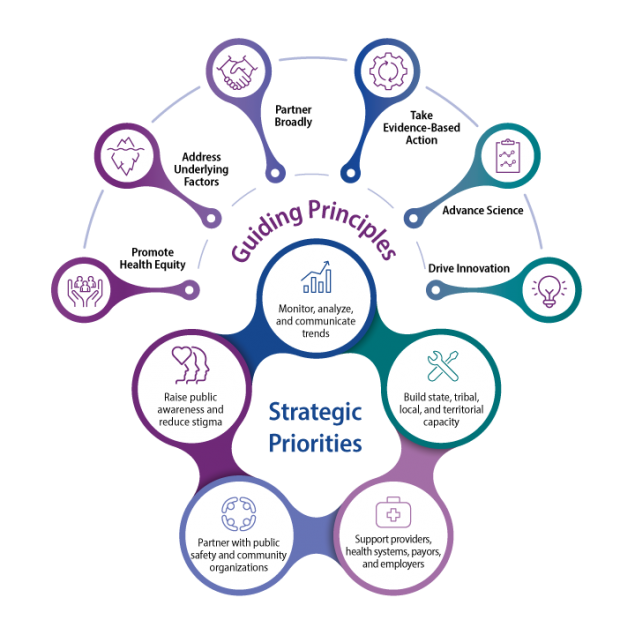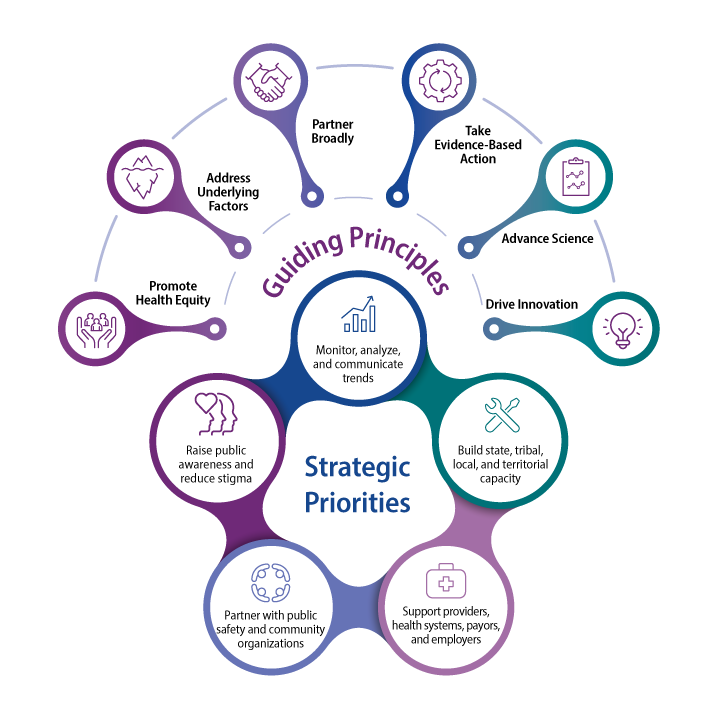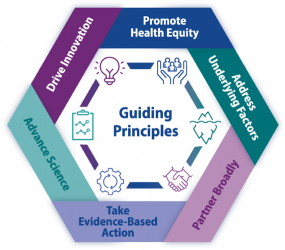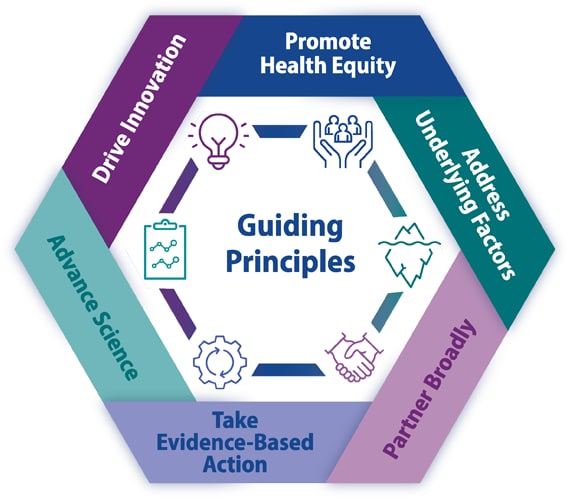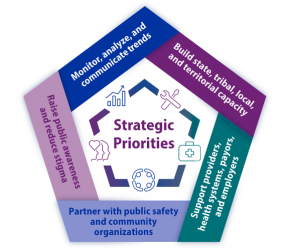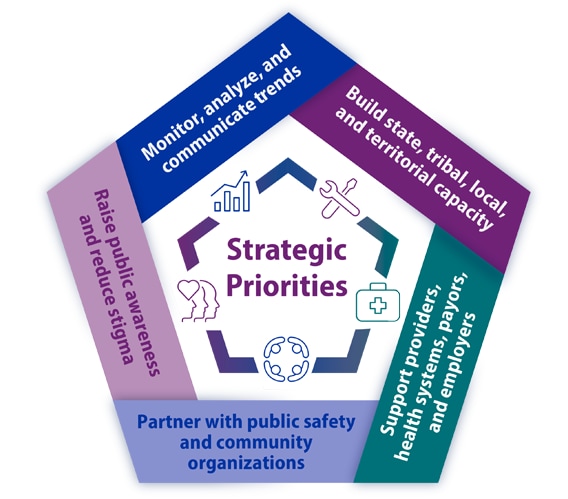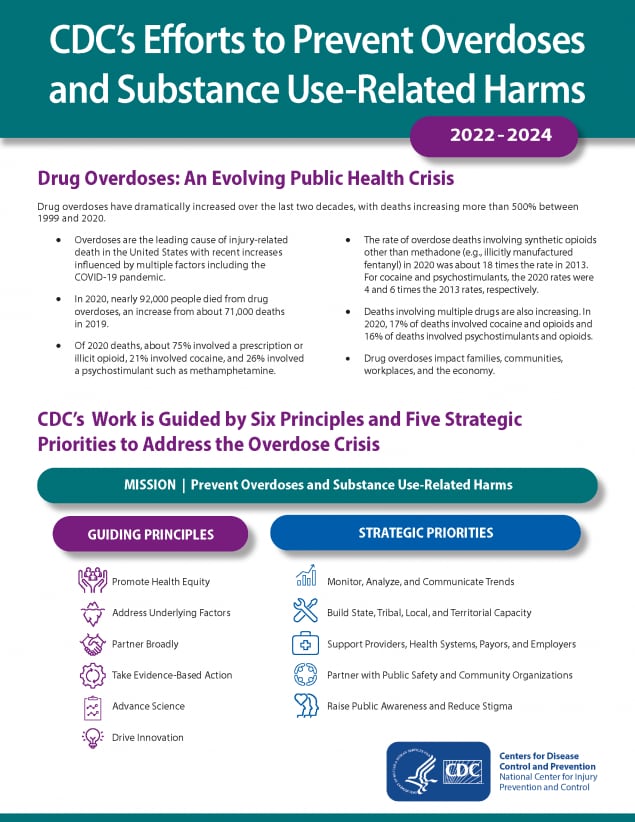Overdose Prevention
Illicitly manufactured fentanyl, heroin, cocaine, or methamphetamine (alone or in combination) were involved in nearly 85% of drug overdose deaths in 24 states and the District of Columbia during January–June 2019. More than 3 out of 5 overdose deaths had at least one potential opportunity to link people to care before the fatal overdose or to implement life-saving actions when the fatal overdose occurred. Read more in CDC’s VitalSigns feature.
Drug overdose deaths can be prevented. See how CDC is working to prevent overdoses and substance use-related harms with the following strategies.
CDC’s Work is Guided by Six Principles and Five Strategic Priorities to Address the Overdose Crisis
All individuals have the right to be as healthy as possible. CDC is committed to ensuring everyone has an equitable opportunity to prevent overdose and substance use-related harms and remains dedicated to addressing and ending health disparities related to the overdose crisis. CDC also promotes actions to advance health equity to ensure all communities can fight the overdose crisis together.
Many factors contribute to harms associated with substance use while other factors can be protective. CDC is committed to identifying these factors to better design and focus interventions to address the overdose crisis, while attending to health disparities and inequities.
Addressing the overdose crisis requires partnering with multiple sectors and organizations within all of CDC’s strategic priorities. Partnerships provide opportunities to develop, coordinate, and implement targeted strategies to prevent harm. CDC is dedicated to broad and diverse partnerships as a foundation of preventing overdose and substance-use related harms.
To better address the overdose crisis, CDC promotes strategies that have been extensively researched by scientists. Evidence-based action ensures the delivery (or implementation) of effective methods for preventing and reducing overdose and substance use-related harms that are translated and adapted for diverse audiences and settings.
Continuing to build the evidence-base for what works to prevent overdose and substance-use related harms is critical to ending the overdose crisis. By advancing science through supporting public health surveillance, identifying risk and protective factors, developing and evaluating prevention strategies, and ensuring effective communication strategies that are adapted for diverse audiences, CDC is committed to building the evidence-base for what works to end the overdose crisis.
The overdose crisis will require new and innovative ideas to prevent overdose and substance use-related harms. CDC promotes the generation, implementation, evaluation, and widespread adoption of innovative ideas to address the overdose crisis in all areas of its work.
Timely, high-quality data help public health officials and other decision-makers understand the extent of the problem, focus resources where they are needed most, particularly among populations disproportionately affected by overdose, and evaluate the success of overdose and substance use-related harm prevention efforts. Recognizing the importance of data, CDC is helping jurisdictions track overdose-related morbidity and mortality as well as use data to inform prevention activities.
States, tribes, local communities, and territories play an important role in preventing overdoses and substance use-related harms. They provide public health leadership; drive innovation; partner and collaborate; leverage surveillance to detect trends; and promote education, prevention (i.e., primary, secondary, and tertiary), and treatment. CDC works with jurisdictions to build their capacity in these and other areas to respond to the overdose crisis.
Providers and health systems are crucial in promoting safer opioid prescribing and more effective and equitable pain management among adults and youth as well as providing evidence-based treatment for substance use disorders, particularly among disproportionately affected populations. In addition, health systems can implement quality improvement measures to track their efforts, integrate these measures into their electronic health records, and support care coordination. Private and public insurers and pharmacy benefit managers can help address the overdose crisis by addressing gaps in coverage, removing barriers to treatment for substance use disorders and pain treatments, and conducting drug utilization reviews. Employers can play a critical role in preventing overdose by offering comprehensive benefits and supporting employees affected by substance use disorders.
CDC continues to build multidisciplinary and diverse partnerships through public health and public safety collaborations at national, state, and local levels to strengthen efforts to reduce drug overdoses. These partnerships allow for effective and equitable implementation of programs and help advance promising strategies that address the overdose crisis, while helping to eliminate the longstanding impact of systemic inequities on overdose prevention. For example, public safety collaborations can reach individuals during critical times such as involvement with the criminal justice system. In addition, partnerships with community organizations can link individuals to substance use disorder treatment or reduce substance use-related harms. These opportunities can bridge knowledge, data, and service gaps that impact the success of community-wide overdose prevention actions.
CDC prioritizes raising awareness about all aspects of substance use including the risks of substance use and preventing associated harms among persons who use drugs, their families, and communities. In addition, CDC promotes evidence-based treatment for substance use disorders and advances understanding that addiction is a chronic disease. CDC also works to reduce stigma because stigma prevents people from seeking help for substance use disorders. CDC reduces stigma by addressing misinformation, endorsing non-stigmatizing language, and promoting awareness of stigma’s impact including among populations disproportionately affected by substance use and overdose.
- Wide-ranging online data for epidemiologic research (WONDER). Atlanta, GA: CDC, National Center for Health Statistics; 2021. Available at http://wonder.cdc.gov.
- Medications for Opioid Use Disorder (MOUD) Study
- Opioid Rapid Response Program (ORRP)
- Overdose Data to Action (OD2A)
- Drug-Free Communities (DFC)
- Evidence-Based Strategies for Preventing Opioid Overdose
- Promising State Strategies and Partnerships
- Prescription Drug Monitoring Program (PDMP)
- Substance Use During Pregnancy
- Opioids Use During Pregnancy
- CDC Vital Sign: Life Saving Naloxone from Pharmacies
- Infectious Diseases, Opioids, and Injection Drug Use
- Laboratory Detection of Synthetic Opioids
- Annual Surveillance Report of Drug-Related Risks and Outcomes (2019)

More work can be done to improve opioid prescribing, prevent misuse of prescription opioids and use of illicit opioids, reverse opioid overdoses, and treat opioid use disorder. Learn more about opioids and opioid overdose prevention.
